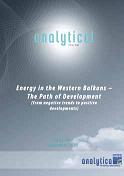Can the International Financial Institutions do more to support new renewables and energy efficiency in southeast Europe?
Can the International Financial Institutions do more to support new renewables and energy efficiency in southeast Europe?
Author(s): Fidanka McGrath, Ana Colovic Leskoska, Pippa Gallop Subject(s): Economy
Published by: Аналитика Тинк-тенк Организација
Keywords: Energy; IFIs; investment
Summary/Abstract: As Europe is “greening” its economy and gearing up to decarbonise by 2050, most southeast European (SEE) countries still view energy efficiency and renewable energy as greens on the side of their main dish. Coal power and large hydropower are still the favorites on the menu, as they depend on indigenous resources and keep energy import dependency lower. At the same time other abundant indigenous resources – the renewable ones – are not utilized, due to a lack of incentives for investors, public institutions and households. SEE countries, driven by EU harmonization processes, have been developing primary and secondary energy legislation in the last few years. Production and distribution of renewable electricity is still very complex in the region, which continues to discourage investors. Legislation on renewable energy certification is yet to be approved and implemented in most countries; agencies and procedures are needed to implement support mechanisms, and licensing procedures tailored to RES projects are lacking. A significant number of renewable energy projects are planned in SEE but it is unclear how many will find financing. The International Financial Institutions are playing a crucial role in the energy sector in the Balkans. The European banks – EIB and EBRD, which will be the focus of this paper – have made considerable investments into improving energy efficiency of transmission and distribution of electricity, and rehabilitation of district heating and existing hydropower plants. Some EE/RES credit lines have been developed via commercial bank intermediaries, along with direct lending facilities, however in the western Balkans these have started only recently and as yet the results are unclear. The IFIs, like other investors, point to legislative and administrative barriers to new renewables and expect that investment will increase as soon as these are removed. At the same time the EBRD and EIB have supported a number of fossil fuel projects and the EBRD is framing as “sustainable energy” projects that may demonstrate some efficiency benefits, but are ultimately keeping the region locked into its carbon “addiction”. In line with EU objectives, national and regional energy strategies should set ambitious aims and mandatory targets for decreasing energy intensity and CO2 emissions and increasing the share of sustainable renewable energy sources (excluding large hydropower plants). EE/RES solutions should be promoted on both the industrial and local/household level, with the active support of the IFIs, where other sources of financing are not available.
Journal: Analytical
- Issue Year: 2010
- Issue No: 06
- Page Range: 8-34
- Page Count: 27
- Language: English

